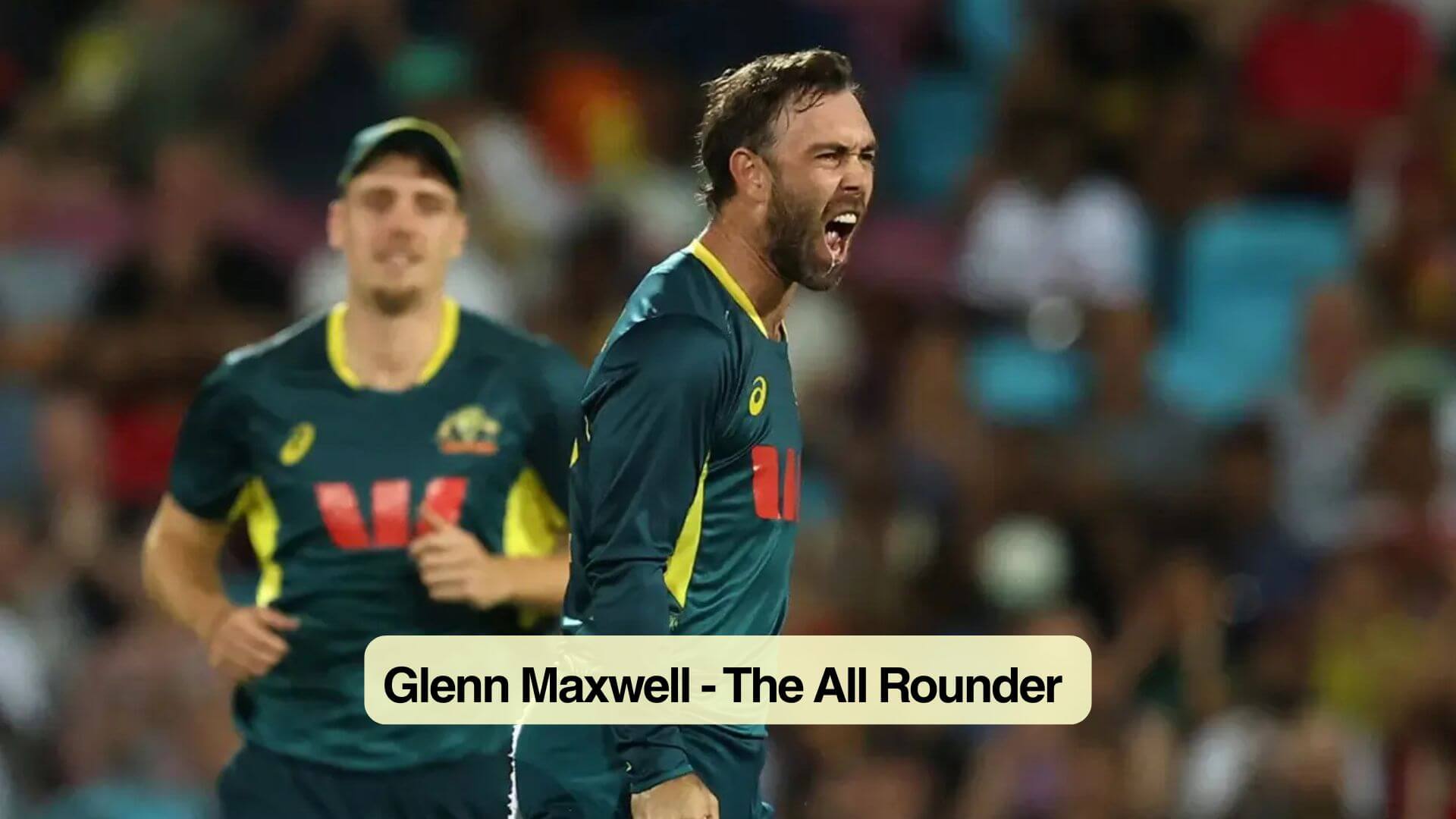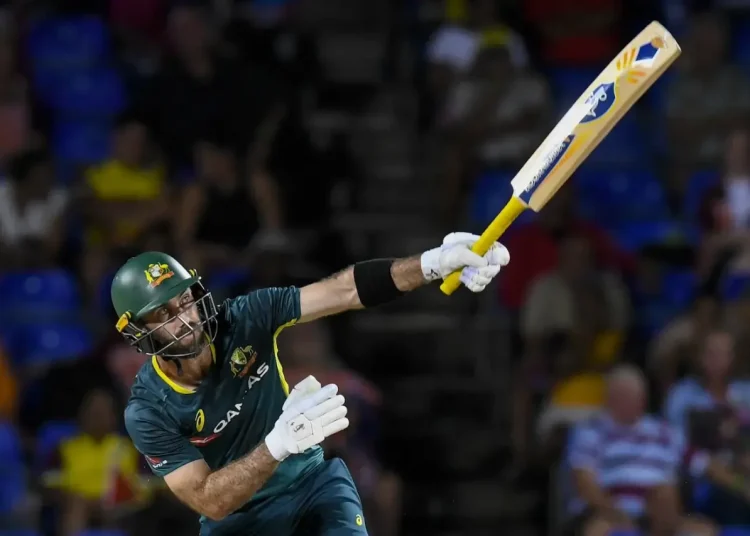Glenn Maxwell has begun gentle mobility work after his recent wrist surgery. His cast was removed this week, giving him freedom to start small hand movements. The aim is clear — to feature in the back-end of the T20I series against India. He missed the first two games but remains hopeful for Hobart or Gold Coast.
Maxwell’s hand therapist has cleared him for light movement and strengthening drills. He now wears a moulded plastic splint to keep the wrist protected. The focus is on rebuilding flexibility without stressing the surgical area. Pain management during batting will decide his actual match readiness.
The injury occurred during net sessions when a fierce drive from Mitchell Owen hit him. He described the moment as freakish and unlucky, similar to past training mishaps. Maxwell has endured many strange injuries over his career, but always bounced back stronger. His determination and fast recovery record remain unmatched among Australian cricketers.
And as always, when Maxwell walks out to bat, cricket gets brighter again. For more insights into India’s upcoming series plans, visit the India vs Bangladesh timeline.
Before the setback, Maxwell was in sparkling form for both Australia and Victoria. His 62 not out against South Africa proved his finishing touch was intact. A few weeks later, his 107 off 82 balls for Victoria reinforced his batting rhythm. The injury may have paused his plans, but it hasn’t dented his spirit.
Road to Recovery and Possible Return Timeline
Maxwell’s recovery plan is simple — regain mobility, restore strength, and return cautiously. He had surgery to fast-track healing rather than rely on natural recovery. Doctors expect a four-week recovery window, giving him a slim shot at the India series. If not, he will be ready in time for the BBL.
His hand therapy began with simple wrist rotations and controlled finger movement. These repetitive motions will rebuild tissue elasticity and nerve responsiveness. He admits the exercises look boring but are essential for long-term progress. The plastic splint will stay on until the bones fully stabilise for cricket motion.
Pain will guide his return timeline more than medical clearance alone. If batting feels comfortable, he could resume net practice before the last three games. Bowling may take longer since wrist angles stress recovery zones heavily. His medical team continues to monitor swelling and resistance levels daily.
Maxwell believes the surgery was worth the risk given the potential return window. Missing the New Zealand series hurt him, but optimism keeps his focus sharp. For now, his goal is simple — stay patient, rebuild movement, and regain power. The fans may soon see him back doing what he does best.
Rehab Progress and Strengthening Work
Each phase of Maxwell’s rehab focuses on a gradual, data-led approach. His physiotherapists track daily motion limits and pain response through mobility tests. Early stages rely on stretching, resistance bands, and mild rotational drills. These help restore flexibility while protecting surgical stitches from excessive stress.
Batting practice will resume once grip and rotation reach safe levels. Short-range hitting drills will rebuild timing and confidence progressively. The process avoids sudden jumps to prevent long-term wrist instability. Fitness coaches supervise every step to ensure proper rest and controlled muscle recovery.
Maxwell says he’s learned from past injuries to respect time and patience. Rushing a comeback often leads to setbacks or repeated strains later. He’s aiming for durability rather than speed in this return phase. If all goes well, he’ll be cleared before the Hobart T20I in early November.
How Maxwell Dominated Other Teams with His Batting?

Glenn Maxwell’s batting thrives on improvisation, anticipation, and calculated aggression. His ability to read bowlers early gives him control over tight situations. Against South Africa, his 62 not out displayed perfect decision-making under pressure. He balanced caution and aggression to chase the target with calm precision, especially against teams like India.
In domestic cricket, he followed it with a clinical 107 off 82 balls for Victoria. That innings showcased placement, timing, and raw power blended in harmony. Maxwell doesn’t just hit big — he chooses bowlers and areas smartly. His creativity underpins why Australia trust him as a match-winner in any condition.
When Maxwell bats, field placements lose meaning because angles vanish instantly. He reverse sweeps fast bowlers, scoops full tosses, and clears straight boundaries. His quick footwork lets him attack spin without losing balance or rhythm. He thrives in the chaos of T20 cricket, turning small moments into dominance.
Every innings of Maxwell follows the same pattern — patience, planning, and destruction. He absorbs pressure before switching gears into explosive finishing mode. That’s why even in his absence, opponents fear his eventual return. Few players can flip a match so completely in just a few overs.
The Finisher’s Mindset and Match Awareness
Maxwell’s finisher role demands clarity and perfect risk assessment every over. He doesn’t pre-decide shots; he reacts to field shape and delivery pattern. His hand-eye coordination allows him to innovate mid-ball without hesitation. That adaptability separates him from ordinary T20 hitters who rely on power alone.
He uses reverse sweeps, ramps, and inside-out drives as tactical responses, not tricks. Every stroke serves a purpose — to break bowler rhythm or shift field balance. Maxwell’s instincts are sharpened by years of short-format experience worldwide. That experience makes him one of the most feared middle-order hitters today.
Behind his flamboyance lies deep match awareness. He tracks bowlers’ slower balls, changes of pace, and subtle grip shifts. This awareness lets him pre-empt variations before they happen in real time. Maxwell calls it “reading the language of the ball” — and he’s fluent in it.
Why Maxwell Is the Opponent Every Dressing Room Talks About

Opposing teams spend long sessions planning how to bowl to Glenn Maxwell. His name dominates team meetings and pre-series briefings every single time. Coaches analyse match-ups and simulate bowling scenarios focused entirely on his style. Few players shape opposition tactics as much as Maxwell does today.
Fielding captains often deploy unusual formations just to restrict his boundary range. Bowlers discuss slower bouncers, yorkers, and field traps designed specifically for him. Even when he’s injured, opponents study his footage for clues and habits. That level of respect underlines his unmatched influence in modern T20 cricket.
For most teams, limiting Maxwell means controlling Australia’s tempo completely. When he fires, run rates skyrocket, and momentum shifts within minutes. Opponents admit his unpredictability makes planning feel like guesswork at times. That’s why Maxwell’s absence from the first two T20Is is seen as relief.
Inside dressing rooms, bowlers speak of him as a one-man momentum disruptor. They discuss lengths, bowling pace, and line variations endlessly before facing him. Yet most admit that once he connects, every plan collapses instantly. His presence alone changes how teams approach the final overs strategically.
The Fear Factor and Tactical Confusion
Psychologically, facing Maxwell creates pressure even before the first ball is bowled. Bowlers know a small error could disappear over long-off or third man. Captains shift fields nervously, trying to predict the unpredictable and guess patterns. That anxiety often leads to misexecution, which Maxwell exploits ruthlessly and instantly.
He thrives on this psychological edge. By staying calm, he exposes opponents’ impatience and tactical panic easily. Teams try everything — spin early, slower balls, bouncers — yet rarely succeed. Even dismissing him doesn’t guarantee relief because he often scores too fast before falling.
Analysts admit planning against him is like solving a new puzzle each match. His shot range and timing make data analysis feel incomplete every time. That fear spreads through the dressing room, affecting confidence across departments. Maxwell becomes a mental opponent as much as a physical one.
Why Maxwell Is Vital for Australia’s 2026 World Cup Plans?

The 2026 T20 World Cup will demand power hitters with big-match experience. Australia views Maxwell as central to their balance and late-overs firepower. His finishing role bridges middle-overs stability and final-overs aggression perfectly. Without him, the team loses tactical flexibility in tight chases and totals.
Selectors believe a fit Maxwell adds value in both batting and bowling depth. His off-spin offers captaincy options in mixed conditions across venues. He’s one of the few who can change games with bat, ball, and fielding. That triple-impact ability makes him a non-negotiable selection when fit.
Coaches plan to track his BBL performances closely before World Cup selection. Consistent match time in December will prove his fitness and confidence level. If pain-free, he’s expected to reclaim his finishing slot in Australia’s plans. His Melbourne Stars captaincy will help sharpen his leadership and tactical instincts further.
By mid-2026, Maxwell could mentor younger hitters like Tim David and Mitch Marsh. His guidance in pressure chases could define Australia’s tournament outcomes. For now, every step of recovery contributes to that long-term goal. A healthy Maxwell means a more balanced, dangerous Australian lineup in 2026.
The Tactical Value of Maxwell in Tournament Plans
Maxwell’s inclusion allows selectors to adjust Australia’s formation around conditions. He can bat at No. 4 or 5, depending on match tempo and strategy. His off-spin creates bowling depth without disrupting primary pace combinations. Captains value his calm temperament and adaptability under knockout-stage pressure.
During chases, Maxwell acts as the designated tempo shifter for acceleration. His ability to score from unorthodox angles opens gaps where none exist. That unpredictability makes him ideal for powerplay recovery or death overs momentum. He becomes Australia’s insurance policy when traditional plans collapse under pressure.
If his recovery continues smoothly, expect selectors to build around his versatility. Coaches already view him as a tactical bridge between experience and innovation. A fully-fit Maxwell strengthens batting, bowling, and fielding dimensions simultaneously. That completeness is why Australia’s 2026 plans depend heavily on his presence.
Conclusion
Glenn Maxwell’s journey from wrist surgery to potential return is a story of resolve. His careful rehab shows maturity, patience, and an athlete’s deep understanding of longevity. The mobility work, light exercises, and cautious optimism define this comeback phase. Each day moves him closer to full recovery and match sharpness again.
For Australia, a fit Maxwell means restored finishing power and tactical depth. His batting brilliance, bowling control, and fielding energy make him irreplaceable. Beyond skills, his mental edge lifts teammates and intimidates opponents equally. That blend of performance and personality shapes Australia’s short-format success formula.
As he eyes the back-end of the India T20I series, his goals stay realistic. Play pain-free, regain timing, and build rhythm heading into the BBL. From there, the path leads toward World Cup 2026 preparation and leadership influence. His story reminds us that passion and patience often rebuild greatness.
Fans should expect Glenn Maxwell to return stronger, smarter, and hungrier for success. His comeback isn’t just about fitness — it’s about unfinished business.











